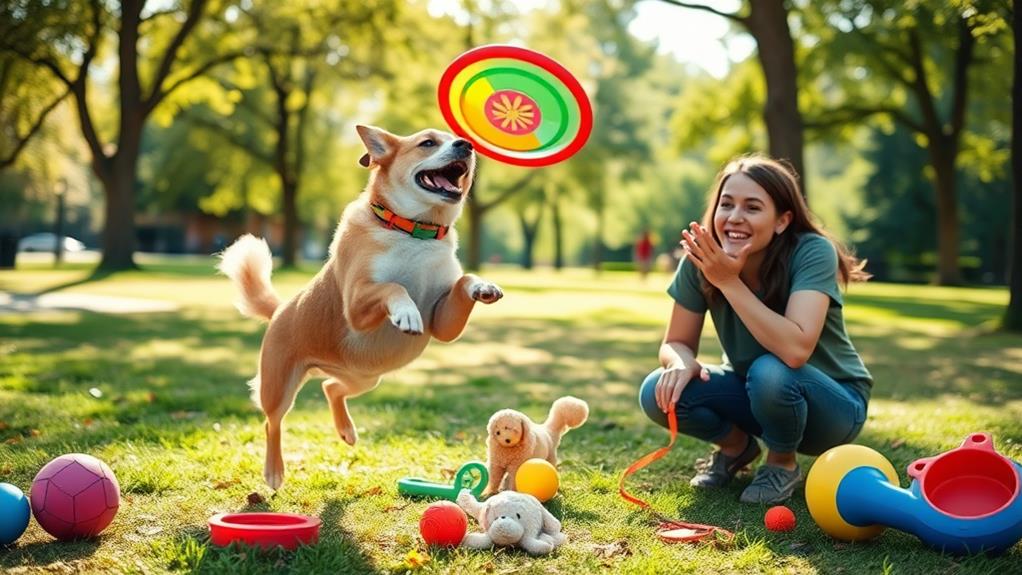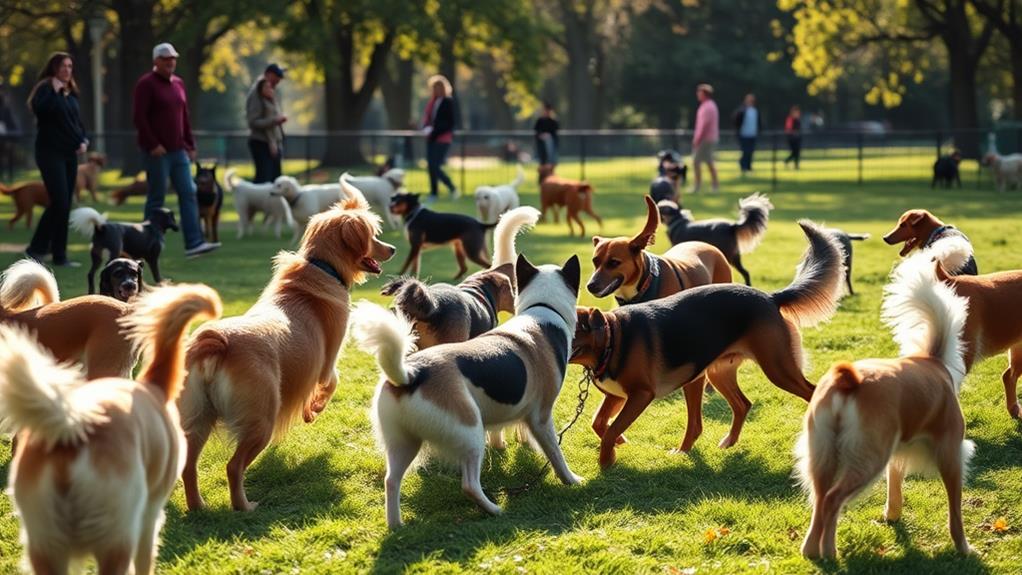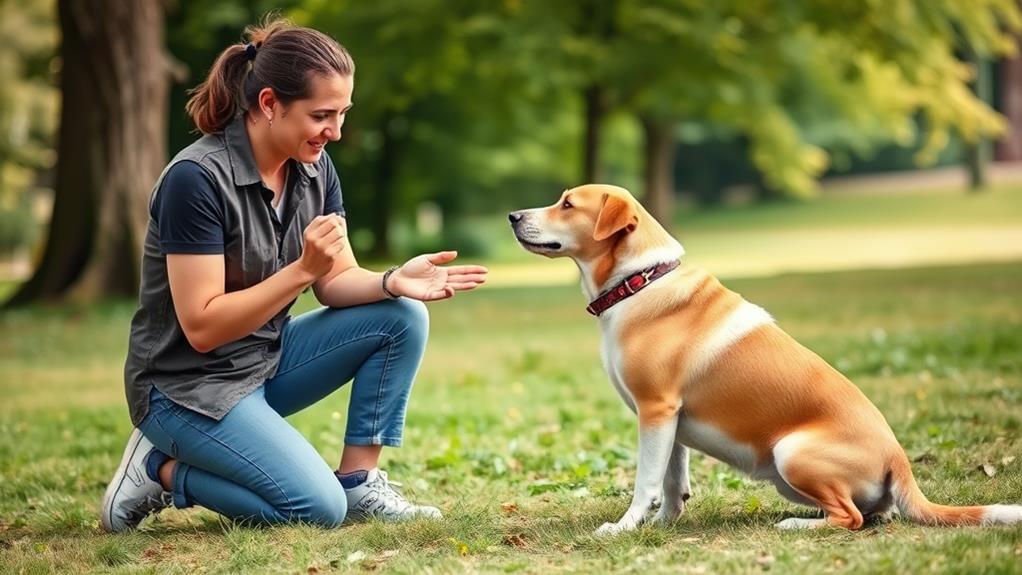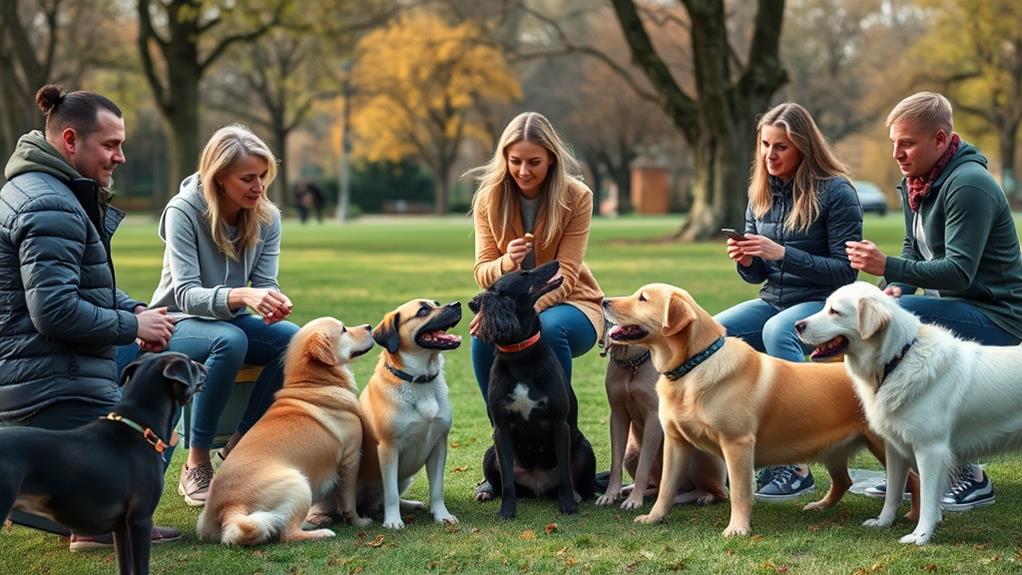To understand your dog's needs, start by observing their body language and vocalizations. Watch for tail position, ear placement, and their posture, as these cues reveal emotions. Pay attention to the sounds they make; different barks or whines indicate various feelings. Consistent training commands and positive reinforcement will strengthen your bond while helping your dog learn. Don't forget about interactive play, routine stability, and socialization with other dogs. Finally, consider professional consultation for persistent issues. Each of these methods will enhance your understanding and connection. Stick around to discover even more ways to communicate effectively with your furry friend.
Body Language Cues

When you observe your dog, understanding their body language cues can be essential to strengthening your bond. Dogs communicate their feelings and intentions through various physical signals.
For instance, a wagging tail doesn't always mean happiness; the position and speed of the wag can indicate excitement or anxiety. A high, fast wag might signify joy, while a slow wag at a lower position could suggest uncertainty.
Pay attention to their ears as well. Erect ears indicate alertness or curiosity, while ears pinned back often show fear or submission. Additionally, watch their posture. A dog that stands tall with a relaxed stance is likely feeling confident, whereas a crouched dog may be feeling threatened.
Facial expressions are key, too. If your dog's mouth is slightly open and relaxed, they're likely at ease. Conversely, a tense mouth or bared teeth can indicate aggression or discomfort. Finally, consider the context of their behavior. By observing these cues in different situations, you'll gain valuable insights into your dog's emotions and needs, fostering a deeper understanding and connection between you both.
Vocalization Interpretation

Understanding your dog's vocalizations is crucial for effective communication. Each bark, whine, and growl carries a message that can reveal your dog's feelings and needs. For instance, a high-pitched bark often signals excitement or playfulness, while a deep bark may indicate alertness or a warning. Pay attention to the context in which these sounds occur.
Whining typically expresses anxiety, discomfort, or a desire for attention. If your dog whines when you leave the room, it might be feeling separation anxiety. Conversely, a soft whimper can suggest that your dog is seeking comfort or needs something.
Growling, often misunderstood, can be a sign of fear, discomfort, or even playfulness. If your dog growls during play, it might be having fun. However, if the growl is accompanied by a stiff body and bared teeth, it's a warning sign that you should respect their space.
Listening closely to your dog's vocalizations and observing their body language will give you a clearer understanding of their emotional state. By interpreting these sounds accurately, you can respond appropriately to your dog's needs and strengthen your bond.
Consistent Training Commands

Consistent training commands are essential for effective communication between you and your dog. When you use the same words or phrases for specific actions, your dog quickly learns what you expect. This clarity helps eliminate confusion and builds trust between you both.
Start with basic commands like "sit," "stay," and "come." Use clear, distinct words every time you issue a command. Avoid using synonyms or similar-sounding words, as this can confuse your dog. For instance, if you say "down" one day and "lay down" the next, your dog mightn't understand what you want.
In addition to verbal cues, pair your commands with consistent hand signals. Dogs are visual learners, so combining verbal commands with gestures can enhance their understanding. For example, raising your hand can signal "stop," while a downward motion might indicate "sit."
Practice these commands regularly in various environments to reinforce learning. Remember, patience is key. Your dog may not get it right away, but with consistent training, they'll understand your commands. This will foster a stronger bond and guarantee your dog feels secure in knowing what you want from them.
Positive Reinforcement Techniques

Positive reinforcement techniques are incredibly effective for encouraging desired behaviors in your dog. By rewarding your pup for good behavior, you create a positive association that motivates them to repeat those actions. Start by identifying the behavior you want to reinforce, whether it's sitting on command or coming when called.
When your dog performs the desired action, immediately provide a reward, like treats, praise, or playtime. Timing is pivotal; the faster you reward, the stronger the association becomes. For instance, if your dog sits when asked, offer a treat right away, then follow it up with enthusiastic praise.
Consistency is key! Use the same commands and rewards every time to help your dog understand what you expect. You can also vary the rewards to keep things interesting—mix treats with verbal praise or playtime to maintain your dog's engagement.
Lastly, be patient. It might take some time before your dog consistently understands the behavior you're reinforcing. Keep your training sessions short and fun to prevent frustration for both of you. With a little effort and consistency, you'll see your dog flourish and respond positively to your commands.
Observing Behavioral Changes

After implementing positive reinforcement techniques, you may notice some behavioral changes in your dog. These changes can indicate your dog's growing comfort and understanding of the training process. Observing these shifts is vital for tailoring your approach and ensuring your dog's needs are met effectively.
Pay attention to the following common behavioral changes:
| Behavior Change | Possible Interpretation | Suggested Action |
|---|---|---|
| Increased Tail Wagging | Happiness and Comfort | Reinforce with praise or treats |
| Improved Eye Contact | Trust and Engagement | Continue positive interactions |
| Reduced Barking | Calmness and Contentment | Maintain a quiet environment |
| Enthusiasm to Follow | Willingness to Learn | Introduce new commands gently |
| Positive Body Language | Confidence and Relaxation | Encourage exploration and play |
Interactive Play Sessions

Interactive play sessions are a fantastic way to strengthen the bond between you and your dog while meeting their physical and mental needs. Engaging in regular play not only keeps your dog healthy but also helps you understand their preferences and personality better.
Here are four effective types of interactive play you can try:
- Fetch: This classic game allows your dog to burn off energy while practicing retrieval skills. It's also a great opportunity for you to reinforce commands like "drop it" or "come."
- Tug-of-War: Using a sturdy rope toy, this game encourages your dog to engage with you physically while promoting teamwork. Guarantee you establish rules so your dog knows when to stop.
- Hide-and-Seek: You can hide somewhere in your home and call your dog to find you. This mentally stimulates your dog and strengthens your bond as they learn to search for you.
- Puzzle Toys: Incorporate toys that challenge your dog to think, such as treat-dispensing puzzles. These stimulate their brain and keep them entertained.
Scent Communication Understanding

Dogs rely heavily on their sense of smell, making scent communication an essential aspect of how they interact with the world. When you notice your dog sniffing around, they're gathering information about their environment, other animals, and even you. Each scent carries a story, revealing details about where a dog has been, what they've encountered, and how they feel.
You might've noticed your dog sniffing your clothes or belongings. This behavior isn't just curiosity; it's their way of connecting with you. The scent of your skin or the food you've touched can provide comfort and reassurance.
Likewise, when your dog marks their territory with urine, they're sending messages to other dogs about their presence and status.
Understanding this scent communication helps you recognize your dog's needs. If they're drawn to a particular area, they might be curious or anxious about something. Responding to these cues can strengthen your bond.
Routine and Environment Stability

Creating a stable routine and environment for your dog is essential for their overall well-being and happiness. Dogs thrive on predictability, and a consistent routine helps them feel secure. You can achieve this by implementing a few simple strategies.
- Set a Schedule: Feed, walk, and play with your dog at the same times each day. This predictability helps them know what to expect.
- Designate Spaces: Create specific areas in your home for eating, sleeping, and playing. This gives your dog a sense of ownership and security in their environment.
- Limit Changes: Minimize changes in your dog's routine and living space whenever possible. If you need to move furniture or change schedules, introduce those changes gradually.
- Stay Calm: Your dog can sense your emotions. Maintaining a calm demeanor during changes will help them adapt better to their environment.
Socialization With Other Dogs

Socialization with other dogs is essential for your pet's emotional and behavioral development. When your dog interacts with others, they learn crucial social skills, like how to read body language and establish boundaries. These experiences can prevent behavioral issues down the line, such as fear or aggression.
To start, consider arranging playdates with friendly dogs or enrolling your pup in a doggy daycare. These environments provide opportunities for supervised interaction, allowing your dog to engage in natural behaviors. Make sure to observe their interactions, ensuring that they're comfortable and not overwhelmed.
Additionally, take advantage of group training classes. Not only do these classes teach obedience, but they also offer a controlled setting for your dog to meet peers. The structure helps your dog learn to focus amidst distractions, which is beneficial for their overall behavior.
Remember to always reward positive interactions with praise or treats. This reinforces good behavior and builds your dog's confidence. Ultimately, regular socialization will create a well-adjusted, happy dog, helping them thrive in various situations and enjoy their time with you and other furry friends.
Professional Behavior Consultation

How can you determine if your dog's behavior needs professional help? If you're noticing persistent issues, it might be time to consult a professional behaviorist. Crucial signs that indicate your dog could benefit from expert guidance:
- Aggression: If your dog shows signs of aggression towards people or other animals, it's essential to seek help immediately.
- Excessive Fear or Anxiety: Dogs that consistently cower, hide, or react fearfully to everyday situations may need professional intervention.
- Destructive Behavior: If your dog is chewing furniture, digging, or engaging in other destructive behaviors, it could signal a deeper issue that needs addressing.
- Inconsistent Training: If your dog struggles to follow commands or exhibits unwanted behaviors despite training efforts, a behavior consultant can provide strategies tailored to your dog's needs.
Professional behavior consultations can offer tailored advice and techniques to help you understand your dog better. By addressing these concerns with a specialist, you'll not only improve your dog's behavior but also enhance your overall relationship with them. Don't hesitate to reach out; your dog's well-being is worth it!
Frequently Asked Questions
How Can I Tell if My Dog Is Stressed or Anxious?
You can tell if your dog's stressed or anxious by observing their body language. Look for signs like excessive panting, a tucked tail, pacing, or avoiding eye contact. Trust your instincts and address their needs promptly.
What Should I Do if My Dog Ignores My Commands?
If your dog ignores your commands, try using positive reinforcement. Reward good behavior with treats or praise. Guarantee your commands are clear and consistent, and consider reducing distractions to help your dog focus better on you.
Are Certain Breeds Easier to Understand Than Others?
Some breeds speak your heart's language effortlessly, while others may feel like a puzzle. You'll find certain dogs are naturally more attuned to human emotions, making it easier for you to understand their needs.
How Does My Dog's Age Affect Communication?
Your dog's age impacts communication profoundly. Puppies might be more playful and curious, while older dogs may show wisdom and calmness. Understanding these changes helps you adapt your approach and strengthen your bond effectively.
Can My Dog's Diet Impact Their Behavior and Communication?
Imagine a painter with dull colors; your dog's diet affects their mood and energy. If they're lacking nutrients, you'll notice changes in behavior. A balanced diet can bring out their vibrant, communicative personality.
Conclusion
By tuning into your dog's unique ways of communication, you can deepen your bond and guarantee they feel understood. Remember, it's important to be patient and attentive, as every dog has its own personality. As the saying goes, "a picture is worth a thousand words"—the same applies to your pup's body language and vocalizations. By combining these methods, you'll be well on your way to translating your dog's needs and enhancing your relationship.



